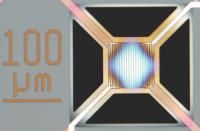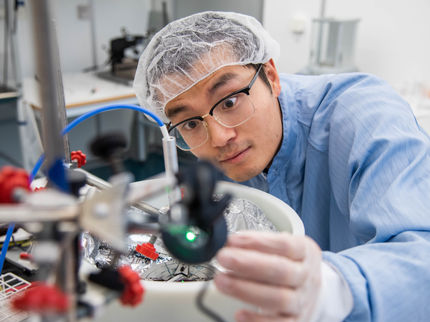New ORNL sensor exploits traditional weakness of nano devices
Advertisement
By taking advantage of a phenomenon that until now has been a virtual showstopper for electronics designers, a team led by Oak Ridge National Laboratory's Panos Datskos is developing a chemical and biological sensor with unprecedented sensitivity.
Ultimately, researchers believe this new "sniffer" will achieve a detection level that approaches the theoretical limit, surpassing other state-of-the-art chemical sensors. The implications could be significant for anyone whose job is to detect explosives, biological agents and narcotics.
"While the research community has been avoiding the nonlinearity associated with the nanoscale mechanical oscillators, we are embracing it," said co-developer Nickolay Lavrik, a member of the Department of Energy lab's Center for Nanophase Materials Sciences Division. "In the end, we hope to have a device capable of detecting incredibly small amounts of explosives compared to today's chemical sensors."
The device consists of a digital camera, a laser, imaging optics, a signal generator, digital signal processing and other components that collectively, much like a dog's nose, can detect tiny amounts of substances in the air.
The underlying concept is based on micro-scale resonators that are similar to microcantilevers used in atomic force microscopy, which has recently been explored as mass and force sensing devices. Although the basic principle is simple – measuring changes in the resonance frequency due to mass changes – a number of obstacles have impeded widespread applications of such systems.
"These challenges are due to requirements of measuring and analyzing tiny oscillation amplitudes that are about the size of a hydrogen atom," Lavrik said. Such traditional approaches require sophisticated low-noise electronic components such as lock-in amplifiers and phase-locked loops, which add cost and complexity.
Instead, this new type of sniffer works by deliberately hitting the microcantilevers with relatively large amounts of energy associated with a range of frequencies, forcing them into wide oscillation, or movement. Lavrik likened the response to a diving board's movement after a swimmer dives.
"In the past, people wanted to avoid this high amplitude because of the high distortion associated with that type of response," said Datskos, a member of the Measurement Science and Systems Engineering Division. "But now we can exploit that response by tuning the system to a very specific frequency that is associated with the specific chemical or compound we want to detect."
When the target chemical reacts with the microcantilever, it shifts the frequency depending on the weight of the compound, thereby providing the detection.
"With this new approach, when the microcantilever stops oscillating we know with high certainty that the target chemical or compound is present," Lavrik said.
The researchers envision this technology being incorporated in a handheld instrument that could be used by transportation security screeners, law enforcement officials and the military. Other potential applications are in biomedicine, environmental science, homeland security and analytical chemistry.
With adequate levels of funding, Datskos envisions a prototype being developed within six to 18 months.
Other news from the department science
These products might interest you
Most read news
More news from our other portals
See the theme worlds for related content
Topic world Sensor technology
Sensor technology has revolutionized the chemical industry by providing accurate, timely and reliable data across a wide range of processes. From monitoring critical parameters in production lines to early detection of potential malfunctions or hazards, sensors are the silent sentinels that ensure quality, efficiency and safety.

Topic world Sensor technology
Sensor technology has revolutionized the chemical industry by providing accurate, timely and reliable data across a wide range of processes. From monitoring critical parameters in production lines to early detection of potential malfunctions or hazards, sensors are the silent sentinels that ensure quality, efficiency and safety.




































































